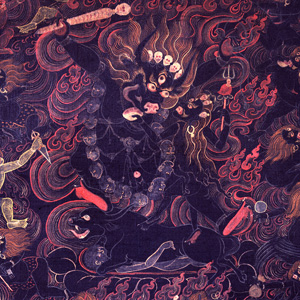
According to the Tibetan text Bardo Thodrol, known in the West as The Tibetan Book of the Dead, death provides an important opportunity for spiritual enlightenment. Upon the moment of physical death a 49-day period, divided into three intermediate states, begins. During this time 100 symbolic deities appear to the deceased in a series of visions. In order to attain nirvana, these visions must be recognized as mere illusions. Otherwise the cycle of rebirth continues.
Buddhists work to embrace impermanence throughout life. By familiarizing themselves with all forms of illusion during life, they can more easily overcome the death visions.
Bardo: Tibetan Art of the Afterlife will present about fifty works of art that illustrate the bardo experiences that confront one upon death. These works from throughout the Himalayan region include paintings and sculptures depicting peaceful and wrathful deities; initiation cards; illuminated manuscripts; a three-dimensional mandala inhabited by afterlife deities; and two shrine room models. Audio-visual devices will allow visitors to view Tibetan death-related ceremonies and rituals.
Related Programs
Bardo and the Resurrection
Tibetan Book of the Dead scholar and translator Dr. Ramon Prats engages with a Christian priest on eastern and western understanding of the afterlife.
Lama Marut Meditates on the Bardo
Sumati Marut (a.k.a. Brian K. Smith) has been teaching religion for 25 years. For the past decade he has been a popular teacher of Buddhist and yoga philosophy, spirituality, and meditation.
The Tibetan Book of the Dead Book Club
A series of seven sessions exploring this seminal guide to the afterlife from seven different vantage points.


